Ah, the Emerald Isle! Ireland, a land steeped in rich history, folklore, and culinary delights that are as diverse as its landscapes. From the hearty dishes that have kept generations of Irish families warm during cold winters to the sumptuous sweet treats that satisfy the most demanding sweet tooth, Ireland’s culinary heritage offers a world of flavors to explore. Join us on a gastronomic journey through the tastes of traditional Irish food, and discover the mouthwatering dishes that have become the cornerstones of Irish cuisine.
Key Takeaways
Explore the staples of Irish cuisine, such as potatoes and soda bread.
Celebrate St. Patrick’s Day with traditional dishes like corned beef and shepherd’s pie.
Enjoy iconic beverages from Guinness to Irish Coffee for a taste of Ireland’s culture
Exploring the Heart of Irish Cuisine: The Staples
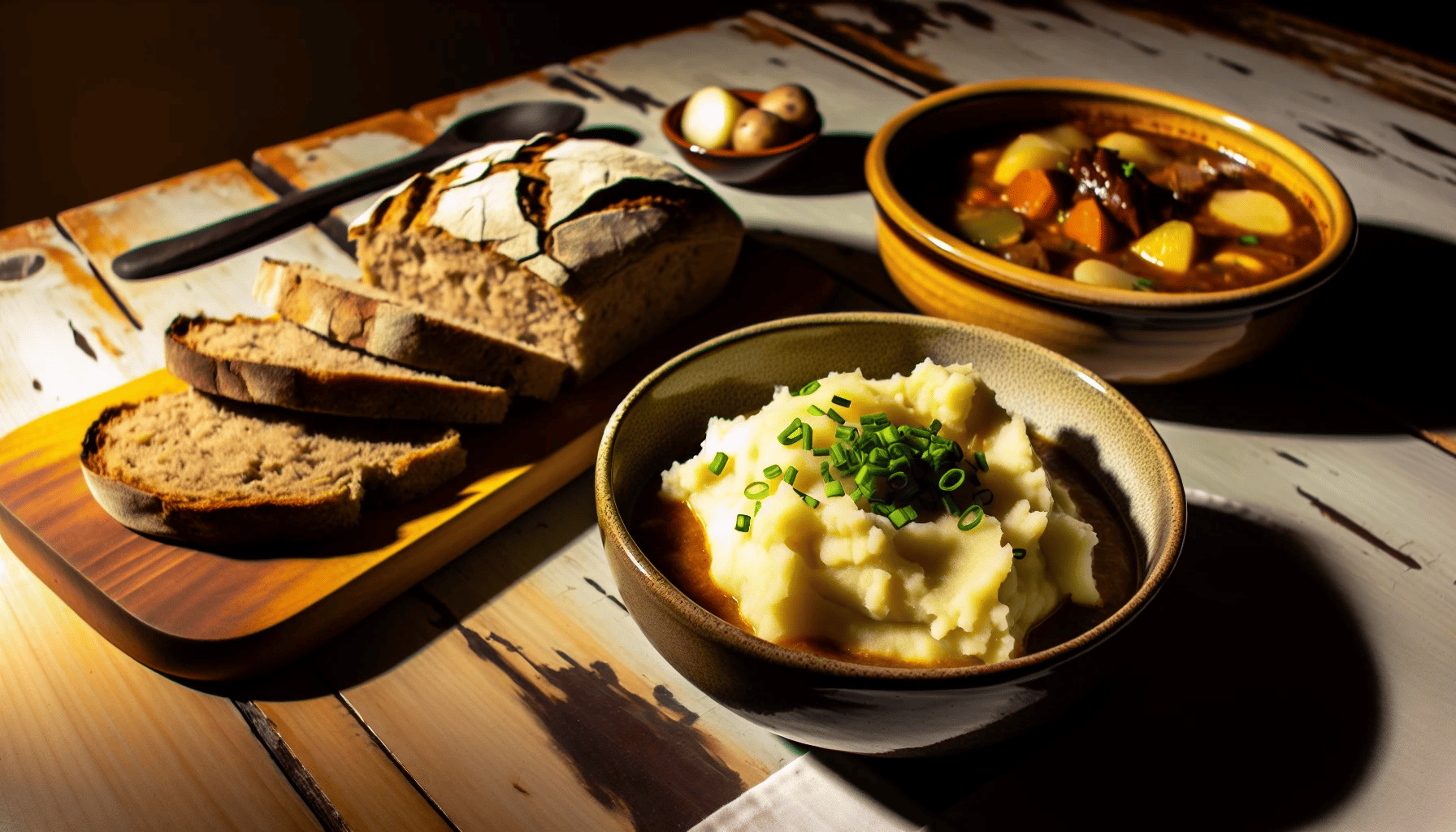
Irish cuisine is rooted in staples that have fed the Irish populace for ages, with traditional Irish cuisine being a prime example. The versatile potato and yeast-free soda bread are among the traditional Irish foods that have influenced the nation’s gastronomic scene.
Discovering these hearty dishes also involves understanding the origins and significance of the famous full Irish breakfast, a staple morning meal deeply ingrained in Irish culture.
The Potato’s Reign in Irish Dishes
Since its introduction in the 18th century, the potato has become an integral part of the Irish diet, highlighting its significant contribution to Irish cuisine. In fact, the humble potato is so versatile that it can be found in a variety of traditional Irish dishes, such as colcannon, boxty, and champ potatoes. The potato’s affordability and accessibility have kept it as a staple in Irish households across generations.
Champ, a delicious dish made from mashed potatoes seasoned with green onions and butter, showcases the potato’s ability to transform into a mouthwatering side dish. Potato farls, a popular component of the Ulster fry breakfast in Northern Ireland, are shallow-fried and buttered to provide additional carbohydrates to the morning meal. Another dish that highlights the versatility of potatoes is Dublin coddle, a slow-cooked meal consisting of bacon and sausage, cubed potatoes, chicken or vegetable stock, and onions. Similarly, potato pancake is a tasty example of how potatoes can be used in various recipes.
Soda Bread: Ireland’s Yeast-Free Wonder
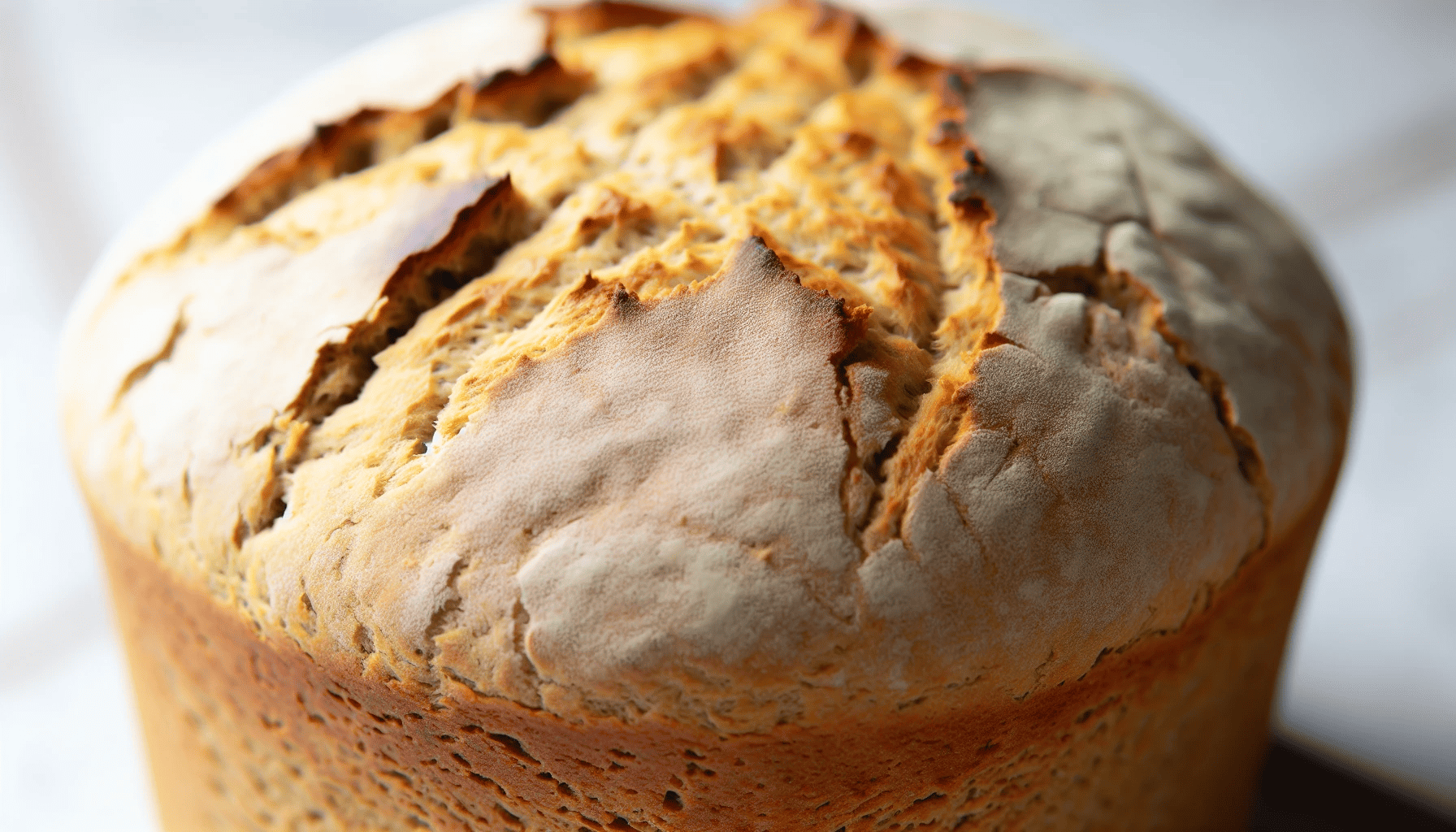
Soda bread, a key element of Irish cuisine, is a yeast-free bread composed of flour, buttermilk, salt, and baking soda. This simple recipe has graced the tables of Irish families for generations, providing a tasty accompaniment to hearty stews and soups. The absence of yeast allows the bread to be prepared quickly, making it a practical and convenient option for busy households.
There are many variations of Irish soda bread, with some recipes including raisins or other dried fruit to add a sweet touch. However, the classic soda bread, often made with wholemeal flour, remains a popular choice in Irish homes. Served with seafood chowder, smoked salmon, or simply spread with rich Irish butter, there’s no denying that soda bread is a beloved part of the Irish culinary experience.
Full Irish Breakfast: A Hearty Morning Meal
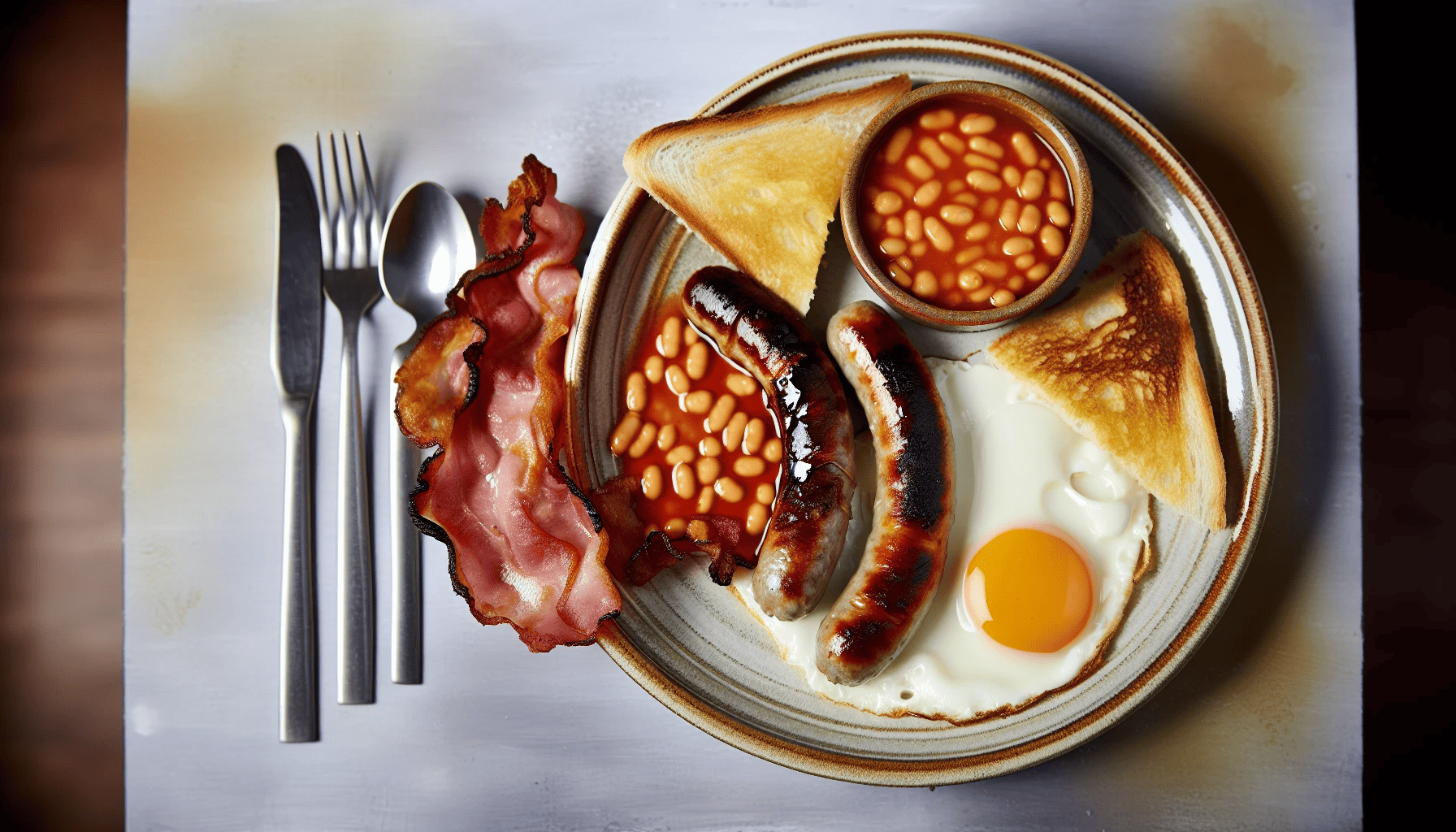
The full Irish breakfast, a protein-rich and satisfying meal, is a weekend staple that symbolizes Irish hospitality. It consists of:
Eggs
Bacon
Sausages
Mushrooms
Baked beans
Grilled tomatoes
Buttered bread or toast
This hearty morning meal provides the energy needed for a full day of work or leisure.
In contrast to its English counterpart, the Irish version of a full breakfast typically includes:
One type of bread
Black and white pudding
The Ulster Fry, a variation from Northern Ireland, adds soda bread and potato bread to the mix, creating an even more filling meal
No matter the variation, the full Irish breakfast remains a beloved and iconic part of Irish cuisine.
Celebrating St. Patrick’s Day with Authentic Irish Fare
St. Patrick’s Day, marked by celebration and revelry, offers the ideal opportunity to savor the authentic flavors of Ireland. From the Irish-American tradition of corned beef to the comforting one-pot wonder of shepherd’s pie, these dishes have become synonymous with the spirit of the Emerald Isle. As we delve into these festive favorites, let us raise a glass to the rich culinary heritage of Ireland.
Corned Beef: An Irish-American Tradition
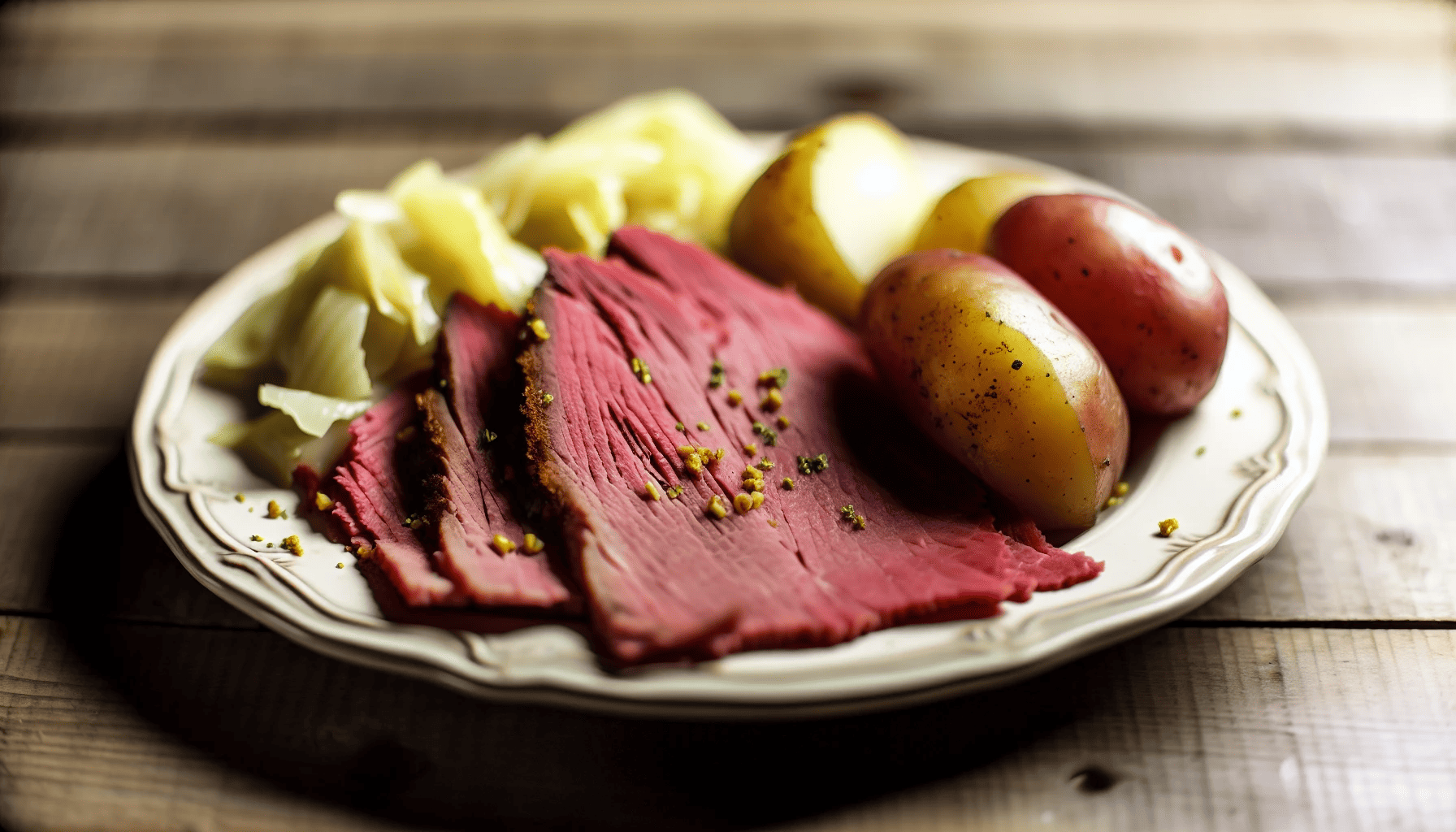
Corned beef, commonly linked with St. Patrick’s Day, has a fascinating history intertwined with the Irish-American experience. Although not a traditional dish in Ireland, corned beef emerged as a popular choice among Irish immigrants in the United States in the late 19th century. These immigrants substituted corned beef for bacon in their traditional dishes because beef was more accessible and cost-effective than pork in the U.S..
Today, corned beef has become a St. Patrick’s Day staple in America, often served with cabbage and other vegetables. The dish is typically prepared by curing the beef brisket for five to eight days, then boiling or slow-cooking it with onions, carrots, and cabbage.
Whether enjoyed at a festive gathering or savored in the comfort of home, corned beef serves as a delicious reminder of the Irish-American culinary heritage.
Shepherd’s Pie: A One Pot Wonder
Shepherd’s pie, a comforting blend of meat, vegetables, and mashed potatoes, is a perennial Irish favorite, relished on St. Patrick’s Day and all year round. Its origins can be traced back to the need for a simple, filling meal that could be prepared with readily available ingredients. Ground lamb or ground beef, combined with an array of vegetables, forms the base of this delicious dish, which is then topped with a layer of creamy mashed potatoes and baked to perfection.
Variations of shepherd’s pie exist, with some recipes incorporating cheese or breadcrumbs on top of the mashed potatoes before baking. This hearty dish is a testament to the practicality and resourcefulness of Irish cuisine, proving that delicious meals can be created from humble ingredients.
Whether served at a St. Patrick’s Day celebration or as a comforting weeknight meal, shepherd’s pie is a true Irish culinary treasure.
The Warmth of Irish Stews and Soups
Amidst cold winds and rain, there’s nothing like a hot bowl of Irish stew or soup to warm the soul. From the hearty food legacy of traditional Irish stew to the coastal delight of seafood chowder, these dishes showcase the warmth and comfort of Irish cuisine.
As we explore these mouthwatering meals, we’ll uncover the unique flavors and ingredients that make them so beloved by those who call the Emerald Isle home.
Traditional Irish Stew: A Hearty Food Legacy
Traditional Irish stew, a meal of root vegetables and typically mutton or lamb, has nourished generations of Irish families with its simplicity and satisfaction. This hearty dish is believed to have originated in the 17th or 18th century, when shepherds and rural farmers relied on a few ingredients to create a nourishing meal that would sustain them through long days of work.
Over time, the recipe for traditional Irish stew has evolved to include locally available ingredients such as carrots, parsnips, and rosemary, as well as the substitution of beef for lamb. Regardless of the variations, the essence of the dish remains the same: a comforting, hearty meal that warms the heart and soul.
Seafood Chowder: Ireland’s Coastal Delight
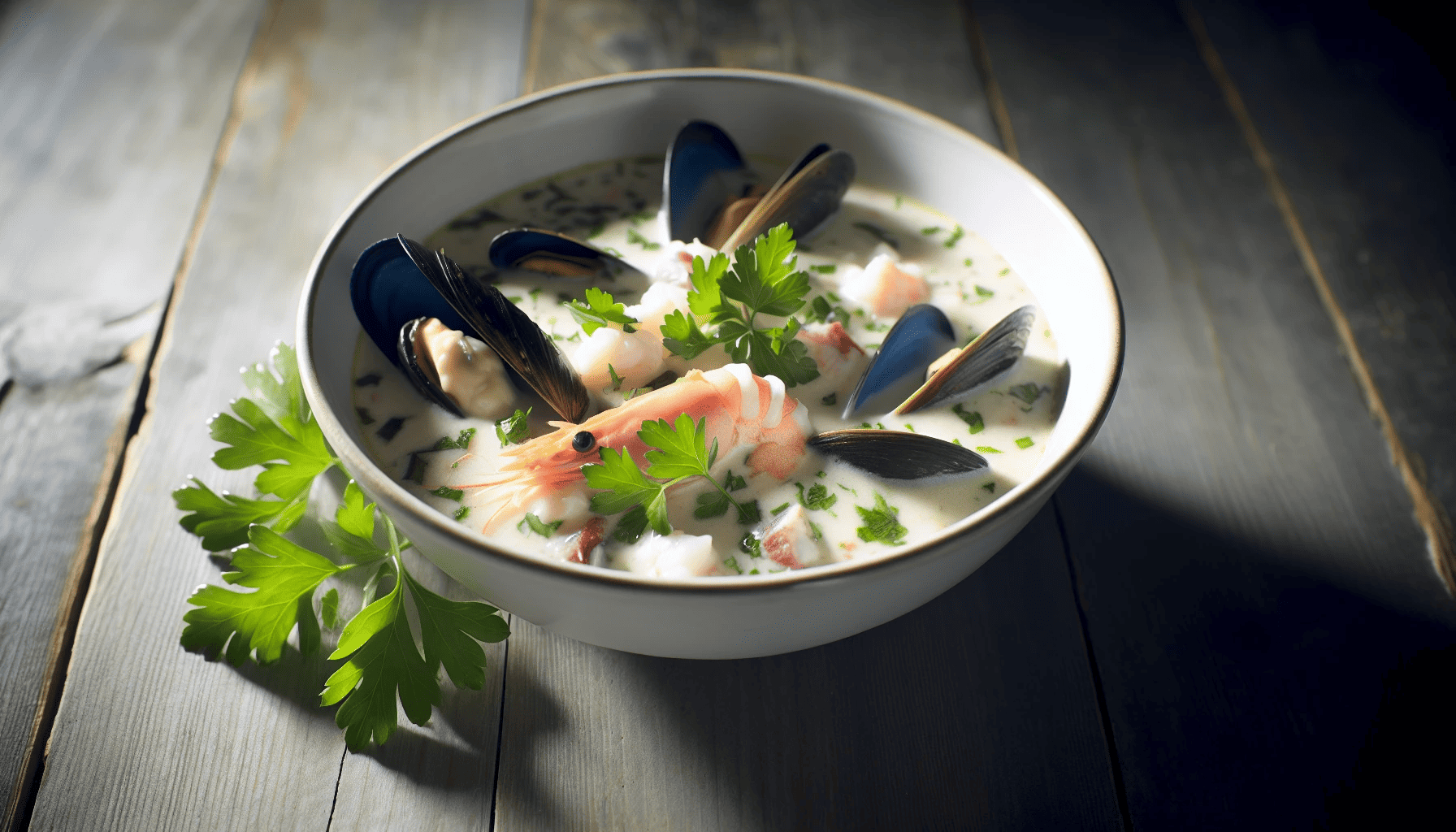
Ireland’s coastal bounty is showcased in the delightful flavors of seafood chowder, a popular dish that combines:
cream
mussels
smoked fish
white fish
in a rich and flavorful soup. This delicious chowder is a testament to Ireland’s love for fresh seafood and its proximity to the bountiful waters of the Atlantic Ocean.
Regional variations of seafood chowder can be found throughout Ireland, with some recipes calling for a mix of fresh and smoked fish, including white fish and salmon. The thickness of the chowder can also vary, with some preparations being thin and light, while others are thick and hearty. No matter the variation, seafood chowder remains a beloved dish that celebrates the coastal flavors of the Emerald Isle.
Sweet Treats and Baked Goods
For dessert lovers, Ireland boasts a variety of tasty treats and baked goods to satiate all cravings. Some popular Irish desserts include:
Irish apple cake
Soda bread pudding
Baileys cheesecake
Guinness chocolate cake
Irish cream truffles
These delectable desserts showcase the sweeter side of Irish cuisine.
Indulge your senses while learning about the history and variations that make these tempting treats irresistible.
Irish Apple Cake: A Sweet Tradition
The history of Irish apple cake can be traced back to County Kerry, where this delicious dessert originated as a spiced cake filled with tart Granny Smith apples and served with a custard sauce. This sweet treat has been enjoyed in Irish households for generations, showcasing the versatility of apples and the warmth of the spices that flavor the cake.
To prepare a traditional Irish apple cake, you will need the following ingredients:
Unsalted butter
Sugar
Eggs
Milk or cream
All-purpose flour
Baking powder
Salt
Spices like ginger and cinnamon
Combine these ingredients to create a fragrant and tender cake. Serve the Irish apple cake with a thick cream or custard sauce for a delightful dessert that has stood the test of time and continues to be cherished in homes across the Emerald Isle.
Soda Bread Pudding: A Twist on the Classic
Soda bread pudding offers a creative twist on the classic Irish soda bread, repurposing leftover bread into a delicious and comforting dessert. This inventive dish has its roots in Irish tradition, dating back several hundred years when soda bread was a staple in Irish homes and a practical solution for busy households.
To prepare soda bread pudding, follow these steps:
Cube leftover soda bread.
In a bowl, combine the cubed bread with ingredients such as milk, eggs, sugar, and vanilla extract.
Mix well until all the bread is coated.
Pour the mixture into a greased baking dish.
Bake in the oven at 350°F (175°C) for about 45 minutes, or until the pudding is set and golden brown.
Serve warm with a dollop of whipped cream or a scoop of vanilla ice cream.
Soda bread pudding is a delightful dessert that is both satisfying and resourceful, showcasing the ingenuity and creativity of Irish cuisine.
The Savory Side of Irish Snacks
Although Ireland’s hearty meals and sweet treats are well-known, the savory Irish snacks also deserve recognition. From the unique black pudding to the flavorful combination of fried cabbage with smoky bacon, these dishes offer a taste of the savory delights that Irish cuisine has to offer.
Learn about the history and ingredients of these satisfying snacks, which are perfect companions for a pint of Guinness or a warm cup of tea.
Black Pudding: Ireland’s Blood Sausage Specialty
Black pudding, a blood sausage specialty, has a long history in Irish cuisine and has been enjoyed by generations of Irish families. This regional delicacy is made from a combination of:
meat
oatmeal or barley
herbs
spices
Black pudding is typically served as part of a full Irish breakfast.
The traditional method of preparing Irish black pudding involves:
Combining pork fat, spices, and pork blood
Cooking it by frying it in butter or oil until the edges are slightly crisped and browned
Some recipes also recommend simmering the black pudding in milk before cooking
With its robust flavor and unique texture, black pudding is a true taste of Ireland’s culinary heritage.
Fried Cabbage with Smoky Bacon
Fried cabbage with smoky bacon is a traditional Irish dish that combines delicate cabbage with flavorful bacon pieces and onions, pan-fried in bacon grease. This simple yet satisfying dish showcases the versatility of cabbage, which has long been a staple in Irish households, and offers a delicious alternative to the more common boiled bacon in traditional Irish cuisine.
The origins of fried cabbage with smoky bacon can be traced back to traditional Irish recipes, which often relied on simple ingredients and easy preparation methods. Today, this dish remains a popular side in Irish cuisine, offering a flavorful and satisfying accompaniment to hearty meals or as a delicious snack on its own.
A Guide to Irish Beverages: From Stout to Whiskey
A culinary journey through Ireland isn’t complete without experiencing the country’s iconic beverages. From the world-famous Guinness stout to the warmth of Irish coffee, these drinks are an integral part of Irish culture and celebrations.
Enjoy a toast to the spirit of the Emerald Isle while learning about the history and flavors of these beloved beverages.
Guinness: More Than Just a Beer
Founded in 1759 by Arthur Guinness in Dublin, Ireland, Guinness has grown from a modest brewery to become Ireland’s largest brewery by 1838 and the world’s largest by 1886. Today, the iconic Irish dry stout is beloved not only in its homeland but also around the globe, with its distinctive harp logo symbolizing Irish culture and arts.
Guinness is brewed using the following ingredients:
Malted barley
Hops
Roasted barley
Yeast
Water
These ingredients come together to create a rich and creamy stout with notes of coffee, chocolate, and a slight bitterness. The brewing process, which involves the careful selection of ingredients and precise fermentation techniques, ensures that each pint of Guinness offers a taste of Ireland’s proud brewing heritage.
From cozy pubs in Dublin to St. Patrick’s Day celebrations worldwide, Guinness is truly more than just a beer.
Irish Coffee: A Warm Welcome
The origins of Irish coffee can be traced back to the winter of 1943, when Joe Sheridan, a chef at Foynes Port near Limerick, Ireland, created the warming beverage to welcome cold and weary travelers. The original recipe, a blend of:
black coffee
whiskey
sugar
cream
Soon found its way to the United States, where it gained popularity in the 1950s.
To prepare an authentic Irish coffee, simply follow these steps:
Rinse a coffee glass with hot water.
Combine brown sugar syrup and Irish whiskey in the glass.
Fill the glass with freshly brewed hot coffee.
Stir the mixture.
Top with a dollop of whipped cream.
Whether enjoyed at a traditional Irish pub or in the comfort of your own home, Irish coffee offers a warm and inviting taste of the Emerald Isle.
Summary
As we conclude our culinary journey through the Emerald Isle, we’ve discovered the rich history and diverse flavors that make traditional Irish food so beloved. From the hearty staples of potatoes and soda bread to the festive delights of St. Patrick’s Day, the warmth of Irish stews and soups, the indulgent sweet treats, the savory snacks, and the iconic beverages that have become synonymous with Irish culture, we hope this exploration has inspired you to delve deeper into the mouthwatering world of Irish cuisine. Sláinte!
Frequently Asked Questions
What are traditional Irish foods?
Traditional Irish foods include Colcannon, Irish stew, bacon and cabbage, boxty, soda bread, coddle, potato farls, Irish white pudding, and barmbrack. All of these dishes are deeply rooted in Irish culture and are favorites of locals and visitors alike.
What is typical Irish pub food?
If you’re looking for a traditional Irish pub experience, be sure to try Shepherd’s Pie, Banger’s & Mash, or Corned Beef – all classic dishes that will have you feeling like you’ve been transported right to Ireland!
What is the difference between black pudding and white pudding?
Black pudding is made with blood, whereas white pudding does not contain any blood, making this the main distinction between the two.
What are the key flavors in Guinness stout?
Guinness stout has a distinctive flavor profile, characterized by notes of coffee, chocolate and a slight bitterness or earthiness. It also has a rich and creamy texture, with a balanced blend of sweetness and bitterness.
What is a traditional Irish breakfast?
A traditional Irish breakfast typically includes eggs, bacon, sausages, mushrooms, baked beans, grilled tomatoes, and buttered bread or toast – a hearty and flavorful way to start the day!

